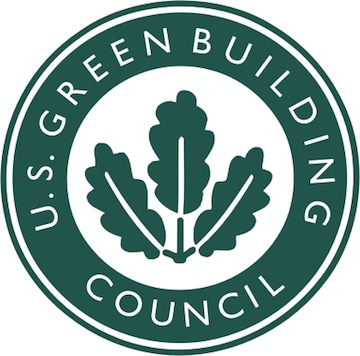The U.S. Green Building Council (USGBC) has released its annual list of the top 10 states for new LEED certifications in 2012, highlighting those regions that are transforming buildings and communities across the country.
The per-capita list is based on 2010 U.S. Census data and includes commercial and institutional buildings certified under LEED, through which approximately 2.2 billion sf has been certified worldwide through 2012.
"Securing a spot on this list is a remarkable achievement for everyone involved in the green building movement in these states," said Rick Fedrizzi, president, CEO and founding chair, USGBC. "From architects and designers to local chapter advocates, their collective efforts have brought sustainable building design and use to the forefront of the national discussion on the environment, and I applaud their efforts to create a healthier present and future for the people of their states."
Once again, the District of Columbia tops the ranking, with 36.97 sf of LEED space certified per resident in 2012.
Meanwhile, Virginia moved into position as the top state, with 3.71 sf certified per resident in 2012, overtaking Colorado, with 2.10 sf certified per person.
Other top states include Massachusetts, which moved up three positions from 2011, with 2.05 sf per person; Illinois, with 1.94 sf; and Maryland, with 1.90 sf of LEED space certified per resident in 2012.
Reflecting the ongoing trend of LEED existing buildings outpacing their newly built counterparts, in 2012 the LEED for Existing Buildings: Operations & Maintenance rating system accounted for 53% of total sf certified in these states, compared to 32% certified under LEED for New Construction.
The full ranking, which includes 10 states plus Washington, D.C., is as follows:
|
Rank |
State |
Projects certified in 2012 |
Square feet of LEED space certified in 2012 |
Per-capita square footage |
|
1 |
District of Columbia |
110 |
22,246,445 |
36.97 |
|
2 |
Virginia |
170 |
29,709,574 |
3.71 |
|
3 |
Colorado |
99 |
10,553,881 |
2.10 |
|
4 |
Massachusetts |
106 |
13,395,597 |
2.05 |
|
5 |
Illinois |
156 |
24,949,997 |
1.94 |
|
6 |
Maryland |
127 |
10,954,324 |
1.90 |
|
7 |
New York |
214 |
34,378,286 |
1.77 |
|
8 |
Washington |
133 |
10,521,177 |
1.56 |
|
9 |
California |
540 |
54,252,993 |
1.46 |
|
10 |
Texas |
224 |
36,017,979 |
1.43 |
|
11 |
Nevada |
29 |
3,741,941 |
1.39 |
"Buildings are a primary focus of our mayor's Sustainable DC initiative," said Keith Anderson, Interim Director, District of Columbia Department of the Environment. "We are indeed thrilled to be leading the nation in per-capita LEED certified space. Our private and public building sectors are boldly leading with the development of high performing green buildings, and we have aligned governmental policies to support such innovation." +
Related Stories
| Sep 12, 2011
PVs play new roles as a teaching tool
Solar installations are helping K-12 schools around the country save money and teach students the intricacies of renewable energy sources.
| Sep 12, 2011
Living Buildings: Are AEC Firms up to the Challenge?
Modular Architecture > You’ve done a LEED Gold or two, maybe even a LEED Platinum. But are you and your firm ready to take on the Living Building Challenge? Think twice before you say yes.
| Sep 12, 2011
Putting a stamp on USPS's first green roof
The Morgan Building roof totals 150,000-sf. In addition to a vegetated green roof, other roof areas were upgraded and included 55,000-sf of reflective concrete pavers and ballast, which were also placed over a Sarnafil waterproofing membrane, and 40,000-sf of EnergySmart Roof—a reflective, energy-efficient vinyl roofing system from Sika Sarnafil.
| May 18, 2011
Carnegie Hall vaults into the 21st century with a $200 million renovation
Historic Carnegie Hall in New York City is in the midst of a major $200 million renovation that will bring the building up to contemporary standards, increase educational and backstage space, and target LEED Silver.
| May 16, 2011
Seattle unveils program to boost building efficiency
Seattle launched a new program that will help commercial property owners and managers assess and improve building energy efficiency. Under the program, all commercial and multifamily buildings larger than 10,000 sq. ft. will be measured for their energy performance using the EPA’s ENERGY STAR Portfolio Manager.
| May 10, 2011
Are green goals out of reach for federal buildings?
Many federal agencies are struggling to convert their existing buildings to meet green standards, according to the Office of Management and Budget. Of 20 agencies graded by the OMB on their compliance with green mandates, only seven met the 2010 mandate that requires at least 5% of their buildings meet energy-efficient and sustainable standards.
| Apr 14, 2011
U.S. embassies on a mission to green the world's buildings
The U.S. is putting greater emphasis on greening its worldwide portfolio of embassies. The U.S. State Department-affiliated League of Green Embassies already has 70 U.S. embassies undergoing efforts to reduce their environmental impact, and the organization plans to increase that number to more than 100 by the end of the year.
| Feb 7, 2011
GSA Unveils New Sustainable Workplace Design Tool
The U.S. General Services Administration launched its Sustainable Facilities Tool on Monday, Feb. 7. The innovative online tool will make it easier for both government and private-sector property managers and developers to learn about and evaluate strategies to make workplaces more sustainable, helping to build and create jobs in America’s clean energy economy of the future.













